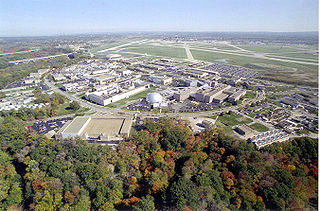
NASA John H. Glenn Research Center at Lewis Field is a NASA center within the cities of Brook Park and Cleveland between Cleveland Hopkins International Airport and the Rocky River Reservation of Cleveland Metroparks, with a subsidiary facility in Sandusky, Ohio. Its director is James A. Kenyon. Glenn Research Center is one of ten major NASA facilities, whose primary mission is to develop science and technology for use in aeronautics and space. As of May 2012, it employed about 1,650 civil servants and 1,850 support contractors on or near its site.

Robert Brent "Bob" Thirsk, is a Canadian retired engineer and physician, and a former Canadian Space Agency astronaut. He holds the Canadian record for the most time spent in space. He became an officer of the Order of Canada (OC) in 2013 and was named to the Order of British Columbia (OBC) in 2012.

STS-42 was a NASA Space Shuttle Discovery mission with the Spacelab module. Liftoff was originally scheduled for 8:45 EST on January 22, 1992, but the launch was delayed due to weather constraints. Discovery successfully lifted off an hour later at 9:52:33 EST on her 14th flight. The main goal of the mission was to study the effects of microgravity on a variety of organisms. The shuttle landed at 8:07:17 PST on January 30, 1992, on Runway 22, Edwards Air Force Base, California. STS-42 was the first of two flights in 1992 of Discovery, the second of which occurred during STS-53, which launched on December 2, 1992. The mission was also the last mission of the Space Shuttle Discovery to have a seven-member crew until STS-82, which was launched on February 11, 1997.
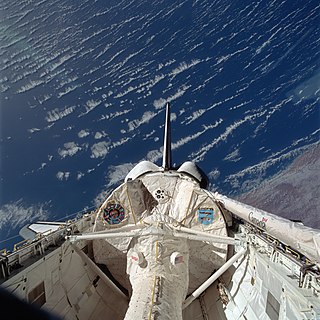
STS-47 was NASA's 50th Space Shuttle mission of the program, as well as the second mission of the Space Shuttle Endeavour. The mission mainly involved conducting experiments in life and material sciences inside Spacelab-J, a collaborative laboratory inside the shuttle's payload bay sponsored by NASA and the National Space Development Agency of Japan (NASDA). This mission carried Mamoru Mohri, the first Japanese astronaut aboard the shuttle, Mae Jemison, the first African-American woman to go to space, and the only married couple to fly together on the shuttle, Mark C. Lee and Jan Davis, which had been against NASA policy prior to this mission.
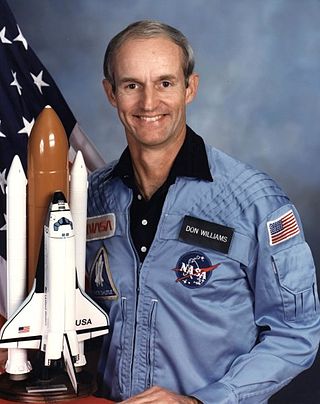
Donald Edward Williams was an American naval officer and aviator, test pilot, mechanical engineer and NASA astronaut. He logged a total of 287 hours and 35 minutes in space.

A reduced-gravity aircraft is a type of fixed-wing aircraft that provides brief near-weightless environments for training astronauts, conducting research, and making gravity-free movie shots.

STS-69 was a Space Shuttle Endeavour mission, and the second flight of the Wake Shield Facility (WSF). The mission launched from Kennedy Space Center, Florida on 7 September 1995. It was the 100th successful crewed NASA spaceflight, not including X-15 flights.
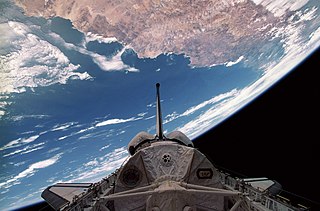
STS-73 was a Space Shuttle program mission, during October–November 1995, on board the Space Shuttle Columbia. The mission was the second mission for the United States Microgravity Laboratory. The crew, who spent 16 days in space, were broken up into 2 teams, the red team and the blue team. The mission also included several Detailed Test Objectives or DTO's.

Skylab 3 was the second crewed mission to the first American space station, Skylab. The mission began on July 28, 1973, with the launch of NASA astronauts Alan Bean, Owen Garriott, and Jack Lousma in the Apollo command and service module on the Saturn IB rocket, and lasted 59 days, 11 hours and 9 minutes. A total of 1,084.7 astronaut-utilization hours were tallied by the Skylab 3 crew performing scientific experiments in the areas of medical activities, solar observations, Earth resources, and other experiments.

Ronald John Grabe, , is a former NASA astronaut.
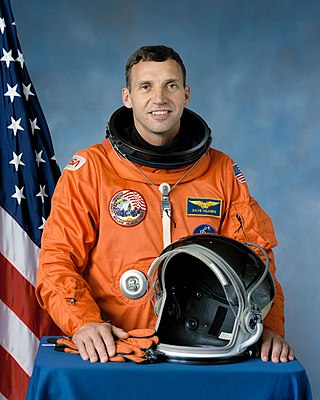
David Carl Hilmers is a former NASA astronaut who flew four Space Shuttle missions. He was born in Clinton, Iowa, but considers DeWitt, Iowa, to be his hometown. He has two grown sons. His recreational interests include playing the piano, gardening, electronics, spending time with his family, and all types of sports. His parents are deceased. With five academic degrees, he is the second most formally educated U.S. astronaut, behind Story Musgrave with six.

Zero Gravity Corporation is an American company based in Exploration Park, Florida, formerly of Fort Lauderdale, Florida, which operates weightless flights from United States airports. Zero-G is governed under Part 121 of FAA regulations enabling the company to cater to both tourists and researchers alike. Zero-G is operated by Everts Air Cargo who holds the 121 certificate.

Weightlessness is the complete or near-complete absence of the sensation of weight, i.e., zero apparent weight. It is also termed zero g-force, or zero-g or, incorrectly, zero gravity.
ELIPS - European Programme for Life and Physical Sciences in Space and applications utilising the International Space Station started in 2001 and was intended to cover the activities for the following 5 years. This Microgravity Programme at the European Space Agency (ESA) is an optional programme, with currently 17 ESA member states participating. The ELIPS programme prepares and performs research on the International Space Station, and other uncrewed mission platforms like Sounding Rockets, in fundamental and applied life and physical sciences. ELIPS is the continuation of the earlier European microgravity programmes EMIR 1&2, and the Microgravity Facilities for Columbus, MFC.
Dropping In Microgravity Environment (DIME) is an annual contest held by NASA's Glenn Research Center. Teams of high school students, with one "faculty adviser", from anywhere in the United States or its territories can enter. The teams prepare and submit proposals for research to be performed; four teams are selected to travel to the Glenn Research Center and perform their experiments at the Zero Gravity Research Facility, in the "drop tower", a deep shaft that can be completely depressurized and thus simulate microgravity when an object is in free fall in it. A further four teams' experiments are selected and conducted by the Center staff. The teams are responsible for writing their proposals, assembly of the necessary equipment if their experiments are chosen to be performed, testing of the setups at their respective homes, and preparation and submission of reports to NASA about their results.

Neutral buoyancy simulation with astronauts immersed in a neutral buoyancy pool, in pressure suits, can help to prepare astronauts for the difficult task of working while outside a spacecraft in an apparently weightless environment.

Vladimir Pletser is Director of Space Training Operations at Blue Abyss since 2018, where he is in charge of developing astronaut training programs. From 2016 to early 2018, he was a Visiting Professor and Scientific Adviser at the Technology and Engineering Centre for Space Utilization (CSU) of the Chinese Academy of Sciences in Beijing, China. He supported the preparation of scientific experiments in microgravity for the Chinese Tiangong space station and for aircraft parabolic flights. He worked previously from 1985 till early 2016 as a senior Physicist Engineer at the European Space Research and Technology Centre (ESTEC) of ESA.

Astronaut training describes the complex process of preparing astronauts in regions around the world for their space missions before, during and after the flight, which includes medical tests, physical training, extra-vehicular activity (EVA) training, wilderness survival training, water survival training, robotics training, procedure training, rehabilitation process, as well as training on experiments they will accomplish during their stay in space.

Made In Space, Inc., is an American company specializing in the engineering and manufacturing of three-dimensional printers for use in microgravity. Headquartered in Jacksonville, Florida, Made In Space's 3D printer was the first manufacturing device used in space.

Expedition 52 was the 52nd expedition to the International Space Station. It officially began on June 2, 2017 10:47 UTC, with the undocking of Soyuz MS-03. Transfer of command from Expedition 51 was done on June 1, 2017.




















